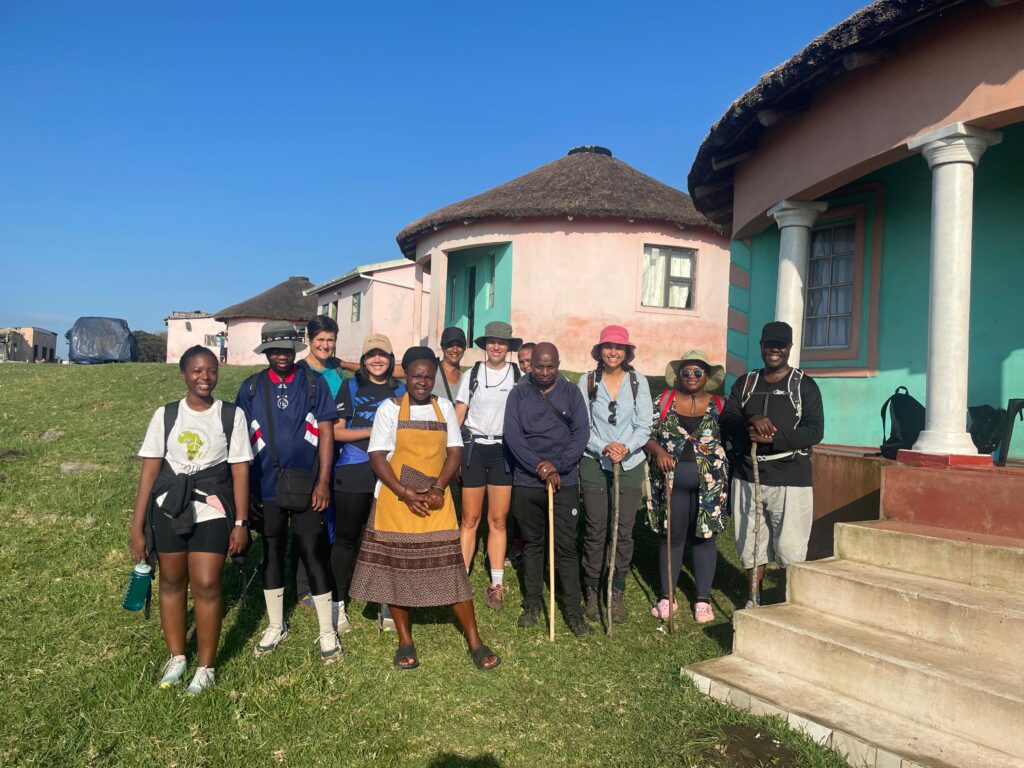Featured Article: Ntando Shobede
In April this year, I had the privilege of going on a staff wellness hike along the breathtakingly beautiful Wild Coast Meander in the Eastern Cape province of South Africa. Our destination was the rural community of Mbizana, home to the amaMpondo people.
Our hiking trail took us through the beautiful ancestral lands of the AmaMpondo tribe. As we walked, we learned so much about their deep connection to this land and their traditional way of life living in harmony with the natural environment. As we trekked across the grasslands and over the enchanting coastal hillsides and plateaus, our guide shared fascinating insights into how the AmaMpondo have lived in harmony with this environment for centuries. As we hiked along the rocky shores, amongst the crashing waves of the Indian Ocean, I felt an incredible sense of peace and connection with the natural world around me. The landscapes were stunningly beautiful – a combination of cragged cliffs, grassy headlands (bumping into herdsmen in their horses, occasionally), and isolated beaches.
Sidenote: cows and sheep from the region must have the best ever mind-state of any of their kind due to their access to the beautiful and calming beaches. But then again, humans and their plastic pollution are a problem.
Our guide [Mr Sinegugu Zukulu, winner of 2024 Goldman Prize for the Africa Region] taught us about the various indigenous plant species found in the coastal forests and grasslands, many of which have been used for centuries by the AmaMpondo people for food, medicine, and even building materials. He pointed out unique flora and fauna, teaching us about the medicinal uses of various wild herbs and plants. There were reminders of how intimately the AmaMpondo way of life is intertwined with the natural world, at every turn. People can easily assume that beautification is a thing of the 21st century, but during this hike I was reminded that using herbs to enhance physical appearances is as old as time. Our guide showed us a tree that young men used to steam with, ultimately making them charming to their female counterparts. As a fellow Nguni man from the AmaZulu tribe, I was excited to learn about the cultural similarities and differences between our peoples ;- even recounting how this is common practice for Zulus too with their use of herbs to even fight skin problems such as acne for adolescents.
At certain points, we could see remnants of the tragic colonial invasion, when the English brutally seized control of these lands from the AmaMpondo. Hearing the dark stories of displacement and oppression gave me a profound appreciation for how this resilient community has fought to preserve their identity, customs, and deep spiritual connection to the earth. We saw a shipwreck from which a 6 year girl, whose parents died when the ship failed to dock at the port not far from Port St Johns, was rescued and went on to marry a Mpondo chief. The story about this shipwreck involved loss of gold which caused a mayhem when settlers from other ports (such as Durban) caught wind of this. Some even dug a hole into the ocean even against many of those who were advising against doing so. These stories were told as we feasted on local dishes like umngqusho (stamp mealies and beans), steamed bread and pumpkin leaves all while absorbing more knowledge about the deep symbolism and mythology underlying AmaMpondo society. In the evenings, we stayed in traditional huts and experienced wonderful amaMpondo hospitality. Similar to my Zulu culture, in a hut; the left side belongs to the women while the right belongs to men. At the upper-most part of the room is umsamo, the most sacred part of the hut.
Our guide walked us through the cultural significance of features like the cattle kraal’s positioning and the positioning of the huts to make the homesteads face a certain direction. Personally, one of the most powerful parts of the experience was the evident similarities to my own Zulu heritage. The layouts of the homesteads, the emphasis on staying connected to one’s roots and ancestors, and the spiritual reverence for the natural world – this resonated deeply. It was a spiritually grounding reminder of the common threads uniting the Nguni peoples.
This wellness trip reminded me of the importance of taking time away from our desks and devices to really immerse ourselves in nature. Being in such an unspoiled, powerful environment gave me a greater appreciation for the delicate balance of our ecosystems and the cultures who have learned to live sustainably within them for generations.
I returned from the hike with a renewed sense of pride in my identity and culture. If there’s one piece of wisdom the AmaMpondo taught me, it’s the importance of living in harmony with the environment and never losing touch with one’s traditions, no matter how modern the world becomes.
